2007 VOLKSWAGEN GOLF PLUS trailer
[x] Cancel search: trailerPage 158 of 541
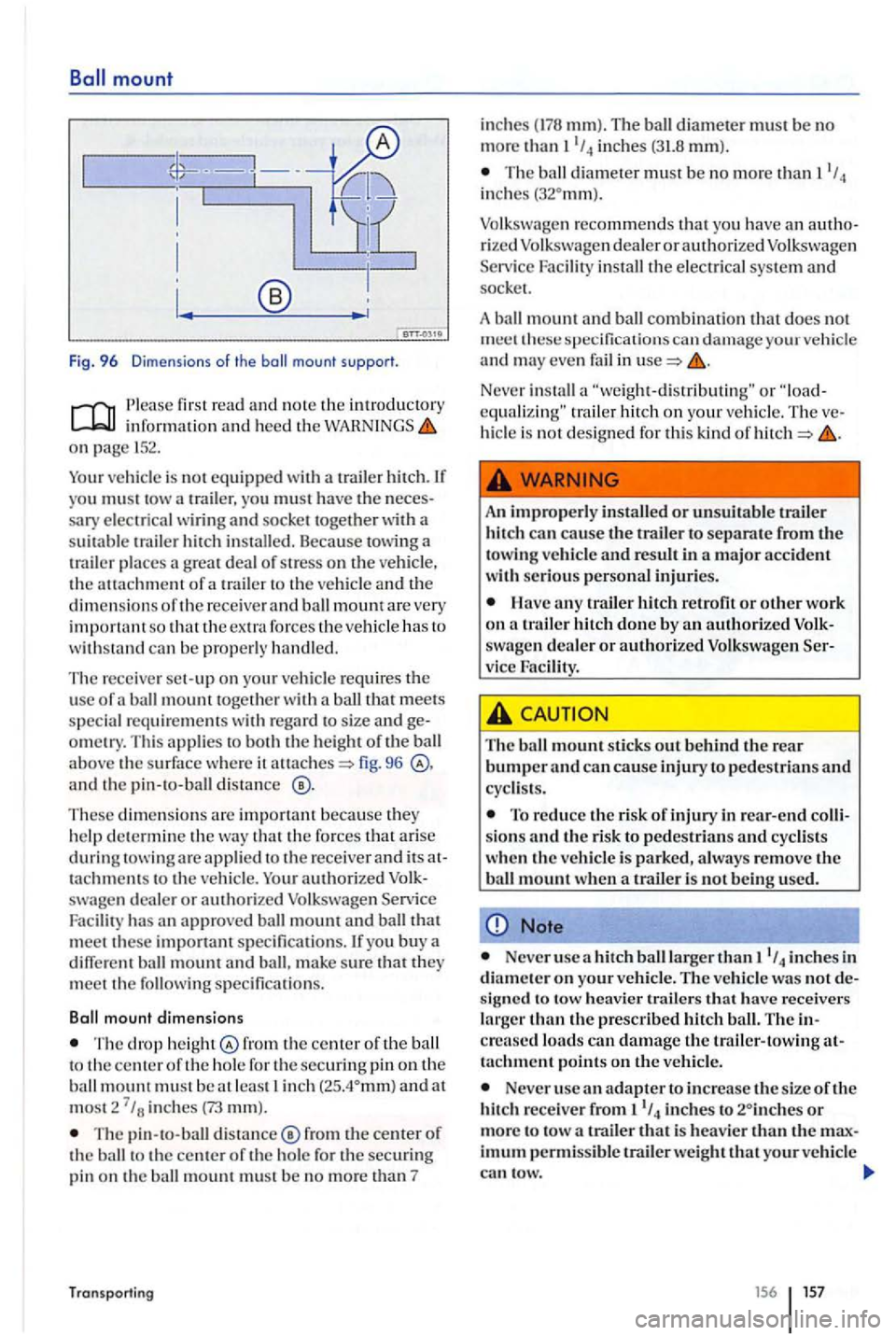
Fig. 96 Dimensions of the mount support.
first read an d note the int rod uctory inform ati o n an d heed th e on 152.
Your vehicle is not equipped with a trailer h itch. you must tow a trailer, yo u must h ave the
ca n be pro perly ha nd le d.
The rec eive r set-up on yo ur ve hicle requ ires the use of ball mount togeth e r a ball that meet s
s pecia l re quire ments with regard to size and om etry. Th is app lie s to bot h th e height of th e ball above the surface where it fig. 96 and th e pin -to-ball distance
These dimen sion s are im po rtant because they h elp dete rmi ne th e th a t the forces that a rise during a re applie d to t he receiver and its tachments to th e ve hicle. Your authori zed dealer or authori zed Volksw agen Service
Faci lit y has approved ball mount an d ball th a t
meet these importa nt specifica tion s. you buy a
diff ere nt ball mount and ball, make s ure that th ey
meet t he following specifica tion s.
Ball
mount dimensions
T he drop heig ht fro m th e ce nter of th e ball to th e cente r of th e ho le fo r th e sec uring pin on th e ball mount mus t b e a t least in ch
T he pin-to -ball dista n ce ® from th e center of th e ball to th e ce nter o f th e hole fo r t he sec uring
pin on th e ball mount must b e no mo re th an 7
Transporti ng
inches mm). The ball diamete r must be no
m ore thanl1
/ 4 in ches (31.8 mm).
T he ball d iamete r must b e no more th a n in ch es
rize d Volkswagen dealer o r a u th o rized Volkswag en
S ervice Facility in stall tl1e electri c a l sys te m and socket.
A ba
ll mount and ball combin ation that does not specifi cat io ns can d amag e your ve hicle and may ev en fail in
o r tr ailer hi tch on you r veh icle . The h icle is not desig ned for this kind of
A n impro pe rl y instal led or unsuit abl e trailer
hi tch can cause the tra iler t o separa te from towing ve hicle and result in a m ajo r ac cident
with seri o us personal inju ries.
H ave any trail er hitch retro fit or
dealer or authorize d Volkswagen vice Faci lity.
Th e ball m ount sti ck s out b ehind th e rear bumper an d can cause injury to pedestria ns a nd
cyclis ts.
T o reduce the risk of inju ry in rea r-end
Note
Neve r usc a hit ch b all larger th an inches in
d ia m ete r o n your vehi cle. The ve hicl e was no t sig ne d t o tow he avier trailers h ave receivers
l a rger than th e pres c rib ed hit ch ball. The cre ased loads ca n d amage the trailer- towin g tachment points on the ve hi cle.
Neve r use adapter to inc rease the size of th e
hit ch r eceive r fr om inches to is heav ie r
Page 159 of 541
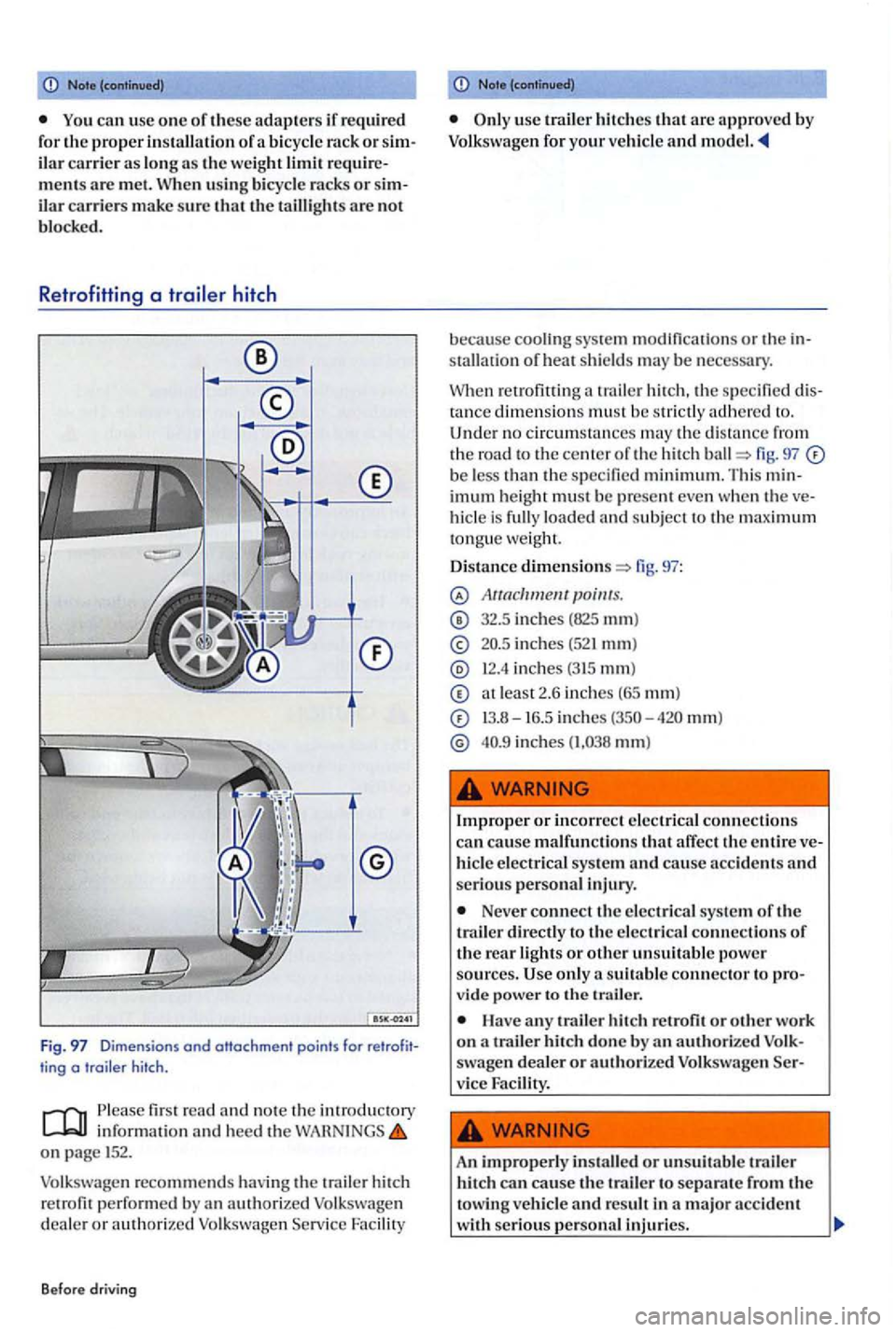
Note
can use one of these adapte rs if required for the proper in stallation of bi cycle rack or
m ent s are m el. Wh en u sin g bicycle rack s or carri ers make sure that th e tailli ghts are n o t
bl ocke d.
Retrofitting a
Fig. 97 Dimensions ond ottochment points for ting o hitch.
first re ad and not e th e intr oductory information and h eed th e on page 152 .
V o lk sw age n rec
ommends hav in g the trai le r hit ch
r e trofit perf o rm ed b y an Volk swag en deale r o r authorized Volk s wa gen Servic e Facility
B efore driving
Note (continued)
use hitches that a re approved by for your vehicl e and
because cooli ng sys te m m od ification s or th e sta llation of heat shield s may be necessary.
Wh en re trofi tting
traile r hi tch, th e specified ta nce dimensions must be stri ctly adhered to. Under no circums ta nces m ay the distance f ro m
th e road to the center o f the hitch fig. 97 be le ss than th e s pecifi ed min im um. Thi s imum height must be present ev e n whe n the hi cle is full y load ed and subje ct to the maximum tongue weigh
D istance fig. 97:
32.5 inch es (825 mm)
in ches ( 52 1 mm)
inc hes (315 mm )
atleast2 .6 in ches (6 5 mm)
13.8-16.5 inches mm)
in ches
Imprope r or incorrect elec tri cal connection s
ca n cause malfunction s that affect th e e ntire hicl e elec tri cal sys te m and cau se acc id e nt s and serio us perso na l injury.
Neve r connect th e e lectrical syste m of the
trailer directly to the e lec trical connectio ns of the rear light s or oth er unsuitabl e power sources . U se only v ide po w er t o th e trailer.
H ave a ny trailer hit ch r etrofit or other work on a trailer hit ch don e by an authorized swage n deal er or authorize d Volkswage n
An improperly in stalled or uns uitable trailer hitcl1 can cause th e trai le r to separate fro m the
towing vehicl e and result in major accident with serious perso nal injuries.
Page 160 of 541
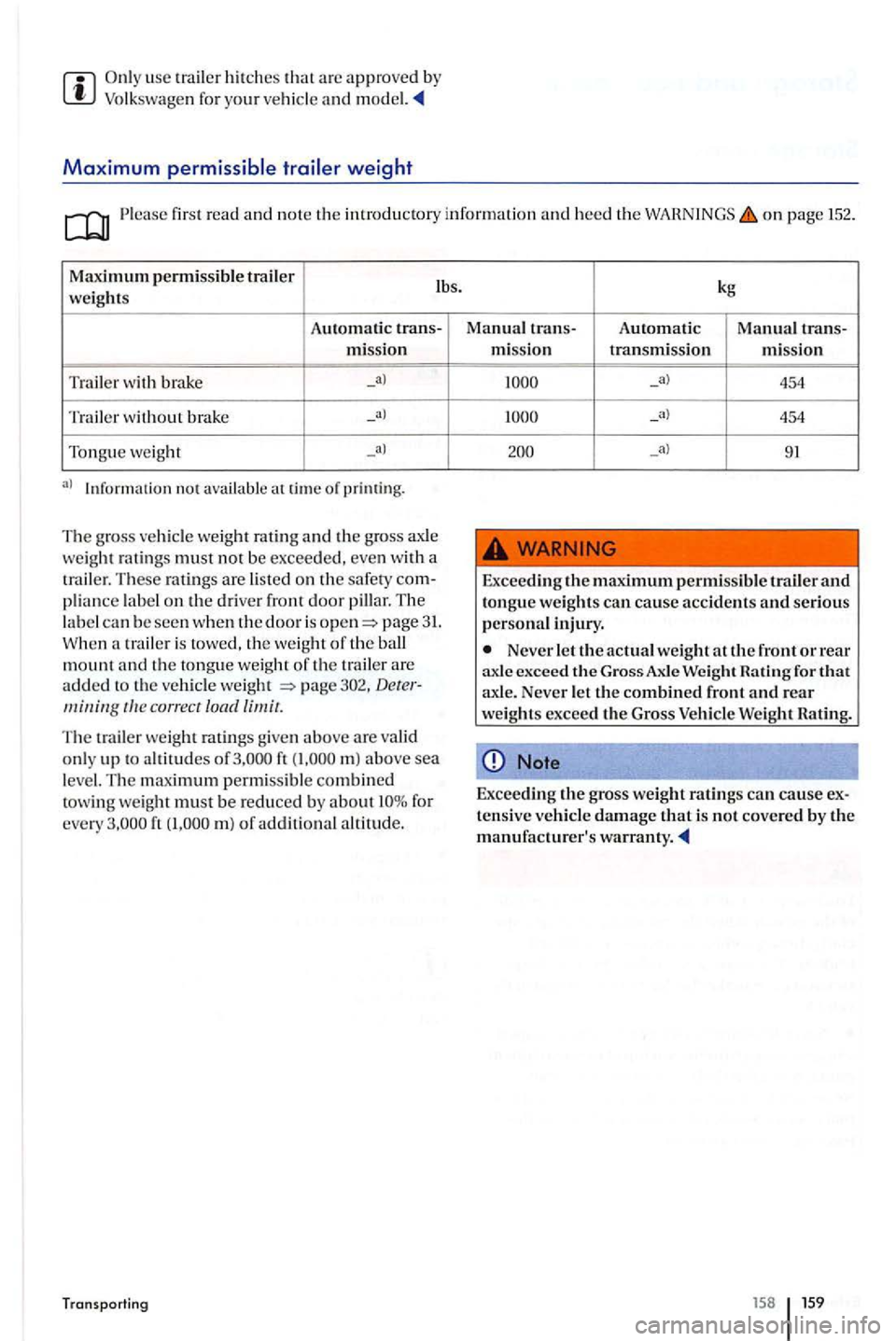
use trailer hitches that are approved b y Volkswage n for your ve hicl e and
Maximum weigh t
first read and note th e introductory informat io n and heed the on page 152.
Maximum permissibl e trailer
lbs.
weights
Automatic trans-mission
Trailer with _a)
Trailer with out brak e -
Tongue weight _a)
lnfonnation not a vailabl e at tim e of printing.
The gross ve hicle weight ratin g and the gross axle
we ight
pliance label on th e d rive r fr ont door pill ar. The
label can be seen when the door i s traile r is towe d, th e we ight of the ball mount and th e to ng ue we ight of the trail er are
ad ded to th e ve hicle weigh t
The trailer we ight
for
eve ry m ) of additi onal alt itu de.
T ransporting k
g
Manual trans-Automatic Manual trans-missio n transmission m ission
_a) 454
_a)
Exceeding the maximum permissi ble trailer and tongue we ight s can cause accidents and seriou s personal injury.
Never le t the actual weight at the front or rear forthat axle. Never le t the combined fr ont and rear
weight s exceed the Gross Vehicle Weight Rating.
Note
Exceeding the gross weight ratin gs can cause tensive ve h icl e damage that i s not co ve re d b y the manufacturer's
158 159
Page 195 of 541
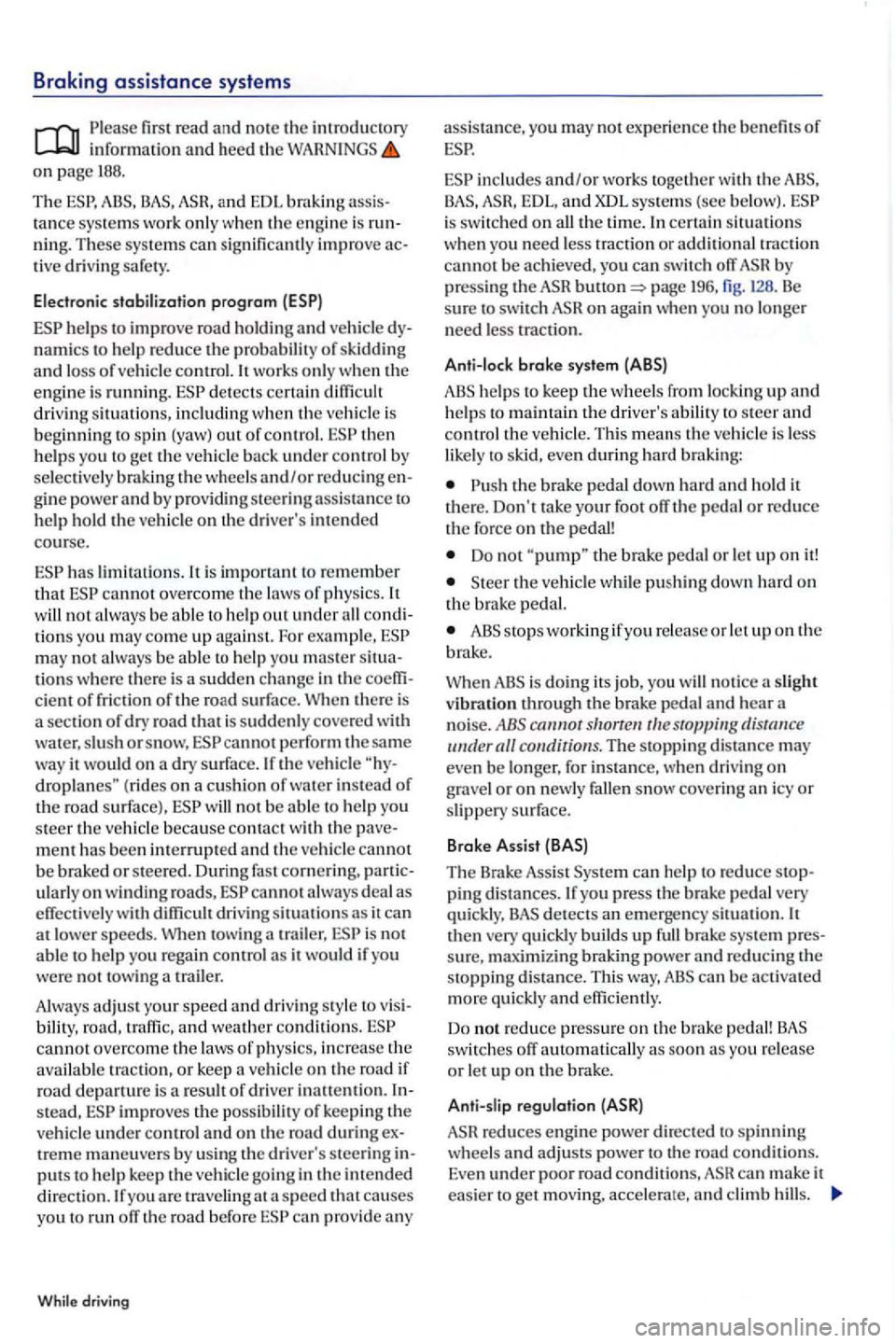
Braking assistance system s
fir st read and n o te the introductory information and heed the
on page
T he and EDL braking tance system s work onl y w he n th e engine is ning. These sys te m s can sig nificantl y improve
vehicle namics to help reduce the probability of skidding and loss o f vehicl e control. works only w hen the engine is running. driving situations, including w hen the veh icle is beginning to spin (yaw) out of control.
gin e power and by providing steering assistance to help hold the ve hicle on the driver's intended
course.
has limitation s.
will not always be able to help out under all tions you m ay come up against. For example, may no t a lways be able to hel p you mas te r tions w he re there is sudde n change in the
cannot perform the sa me
way it would on a dry surface. the vehicl e
cornering. ularly on winding road s, cannot always deal as
e ffectiv ely wi th diffi cult drivin g situations it can
a t lower speed s. When towin g a is not able to help you regain control as it would if yo u were not towing a trailer.
Alway s
adjust your speed bility, road, cannot overcome the laws of phys ics, increa se the available
stead, improves the possibil ity o f keeping th e
vehi cle under control and o n th e road during treme maneuvers b y using th e driver's s teerin g puts to help keep the vehicle going in the int ended direction .lf you a re tra velin g at a speed that causes yo u to run off th e road before can provide any
EDL , and XDL syste m s (sec be lo w). is switc hed on all the tim e. certain situati ons
w he n you need less traction or additional tract ion cannot be achieved, you can swit ch off by pressing page 196, fig. l28. B e
s
ure to switch ASR on again when you no longer
need less traction.
Anti-lock
brake system (ABS)
ABS helps to keep the wheels from l ocking up and helps to maintain t h e driver's ability to steer and control the vehicle . Thi s means the vehicle is less lik ely to skid, even during hard
th e brake pedal down hard
Do not the brake pedal or letup on it!
S teer the vehicl e while pushing down hard on the brake pedal.
ABS sto ps working if you re lease or let up on th e brake.
When is doing i t s job, you will notice
noise. T he stopping di stance may even be lo nger, for instance, when dri ving on
pin g distances.lfyou press the pedal very quickly, BAS detects an e m ergency situ ation.
pedal! BAS
s w itches off automaticall y as soon
reduces en gine power d irected to spinning wheels and adjus ts power to the road conditions.
Eve n under poor ro ad conditions,
Page 200 of 541
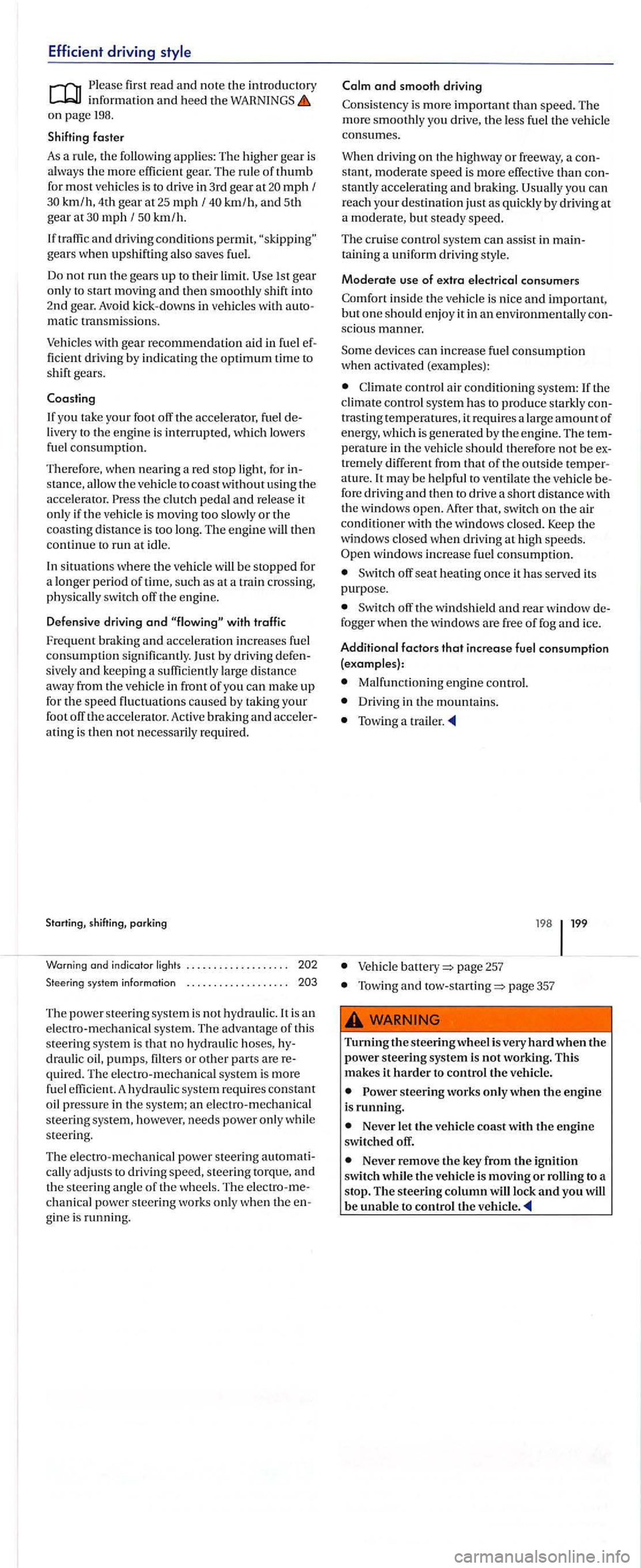
Efficient driving
Please information and heed the on page 198.
Shifting faster
As a rule, the following applies: The higher gear is
a lways the more efficient gear. The rule of thumb for most vehicles is to drive in 3rd gear at mph f km/h, 4th gear at 25 mph f km/h, and 5th gear at mph f km /h.
If
and driving conditions permit, gears when upshifting also saves fuel.
Do
not run the gears up to their limit.
mati c transmissions .
Vehicles with gear recommendation aid in fuel fic ient dri ving by indicating the optimum time to shift gears.
livery to the engine is interrupted, which lowers
fuel consumption.
T herefore, when nearing a red stop light , for s tanc e, allow the vehicle to coast without using the accelera tor. Press the clutch pedal and release it only if the v ehicle is moving too slowly or the coasting distance is too long. The engine will then continue to run at idl e.
In situati ons
where the vehicle will be stopped for
a longer period of time, such as at a train cros sing,
physically switch off the engin e.
D efens ive driving
and with traffic
Fre
quent braking and accel eration increases fuel consumption sign ific antly. Just by driving sivel y and keeping a su fficiently large distance away fro m the vehicle in front of you can make up for the speed fluctuation s caused by taking your foot off the accelerator. Active braking and ating is then not necessarily required.
system information
The power stee ring syste m i s not hydrauli c.lt is an electro-mechanical syste m. The advantage of this
s te ering system is tha t no hydra uli c hoses, draulic oil, pumps, filters or other parts are quired . Th e e lectro-m echanica l system is more fue l effi cient. A hydraulic system requires constant oil pressure in the syste m; an electro -mechanical
s teerin g sys tem, however, needs power only whil e
s teering.
Th e el
ectro-mechanical power steering
chanical power steering works only when the gin e is running.
and smooth driving
Consistency is more important than speed. The more smoothly yo u drive, the less fuel the vehicle consumes.
When driving on the highwa y or freeway, a
stantly accelerating and braking. you can r each your destinatio n just as quickly by driving at a moderate, but steady speed.
The c rui se control syste m can a ssis t in
sciou s manner.
Some dev ices can increase fuel consumption when activated (examples):
C limate control air conditioning system:
trasting temperatures, it requires a large amount of energy, which is generated by the e ngin e. T he
tr emely different from that of the outside
windows increase fuel consumption.
Switch off seat heating once it has served its
purpose.
Sw itch off the windshield and rear window
Malfunctioning engine control.
Driving in the mountains.
Towing a trailer .
page 257
Towing and page 357
Turning the steering wheel is very hard when the power steering system is not working. This makes it harder to control the vehicle.
steering works only when the engine is running.
Never let the vehicle coast with the engine switched off.
Never remove the key from the ignition
switch while the vehicle is moving or rolling to a
stop. The steering column will lock and you will be unable to control the vehicle.
Page 205 of 541
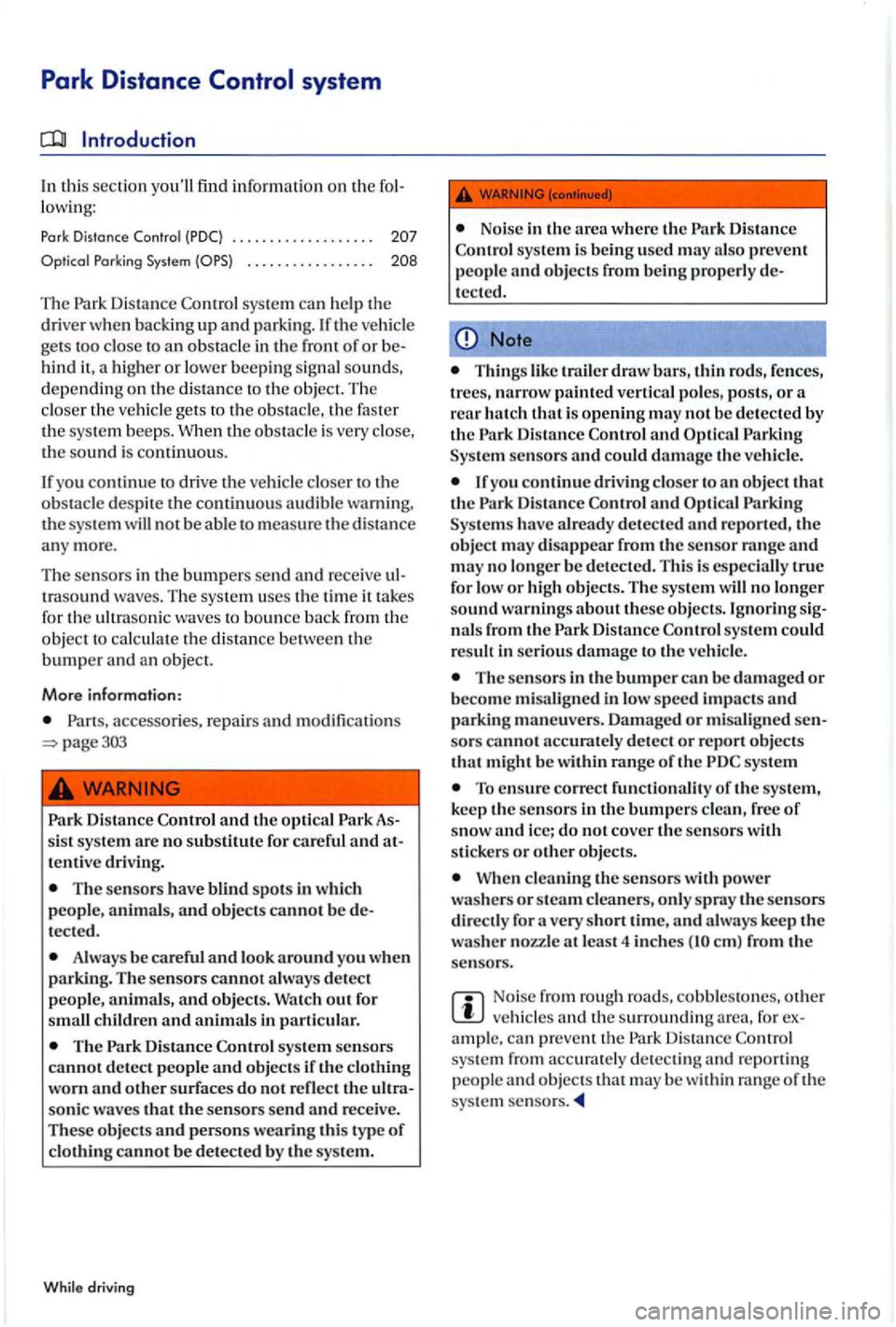
Park Distance
Introduction
In this section you'll find on the lowing :
Pork Distanc e Control (PDC) . . . . . . . . . . . . . . . . . . .
. . . . . . . . . . . . . . . .
The Park Dis tance sys te m can help the
dri ver w hen backi ng up and parking. If the vehicle
gets too close to an obstacl e in the of or hind
trasound waves. The sys te m u ses the tim e it ta kes for the ultra sonic w aves to bo un ce back from the
object to ca lc ul ate the distance between th e bumper and an object.
More information:
Parts, accessories, repairs and modifications
and th e optical
tentiv e driving.
The sensors have blind spots in which
peopl e , animals, and objects cannot be tected.
Always be careful and look around you when
parking. The sensors cannot alwa ys detect
p eo ple, a nimals , and objects . W atc h out for small children and animals in parti cular .
The sys te m sensors cannot d etect p eople and obj ects if th e clothing worn and other surfaces do not reflect the sonic waves that the sensors send and rece ive .
These objects and persons wearing this type of clothing cannot be detected by the sys tem.
While driving
Noise in the area where the Distance sys tem is being used may also prevent
peopl e and objects from being properly tecte d .
Note
T hing s lik e trailer draw bars, thin rods, fences, tree s, narrow painted vertical poles, pos ts , or a rear hatch th at is opening may not be detected by the and Opti cal Sys te m sensors and co uld damage the ve hicl e.
If you continue drivin g closer to an object that
th e
Systems have already detec te d and reported , the obj ec t may di sappear from the se nso r rang e and may no longer be detecte d . This is es pecially true for low or hi gh object s. The system will no longer
sound warnings about these objects. Ignoring nals from the sys tem could res ult in seriou s dama ge to th e ve hicl e.
The sensors in the bumper ca n be damaged or be co me mi salig ned in low spee d im pacts and parking maneuv ers. Damag ed or mi saligned
T o ensure correct functionality of the sys te m ,
keep the se nsors in the bumpers c lean, free of snow and icc; do not cover the se nsors with
s tickers or o th er objects .
When cleaning the senso rs with power
washer s or steam clean ers, only spray the sensors
d ire ctly for a very short time, and alway s keep the
washer nozz le at least 4 inches em) from the sensors.
Noise from rough roads, cobb les tones, other ve hicl es and the surr ounding for ample, ca n p reve nt th e Park Dis ta nce sys te m fro m acc urate ly detecting and report ing
p eople and objec ts that be w ithin range of th e
sys te m se nso rs.
Page 208 of 541

The
vehicl es with a factory-installed trailer hitch
a nd an elec trically co nn ected a corre
s p ondin g grap hic is displayed on th e sc reen. Dis
tan ces behind the vehicl es will not be displayed.
Drive r assis tance systems
Never rely completely on the
The sensors have blind spots where they
cannot detect persons or objects.
Never pay so much attention to the and the graph ics shown on the screen that you fail to notice what is go ing on around you.
Always watch for people, especially s mall
children and animals, because tl1e sensors may
not always be able to detect t11em.
208 209
Page 219 of 541
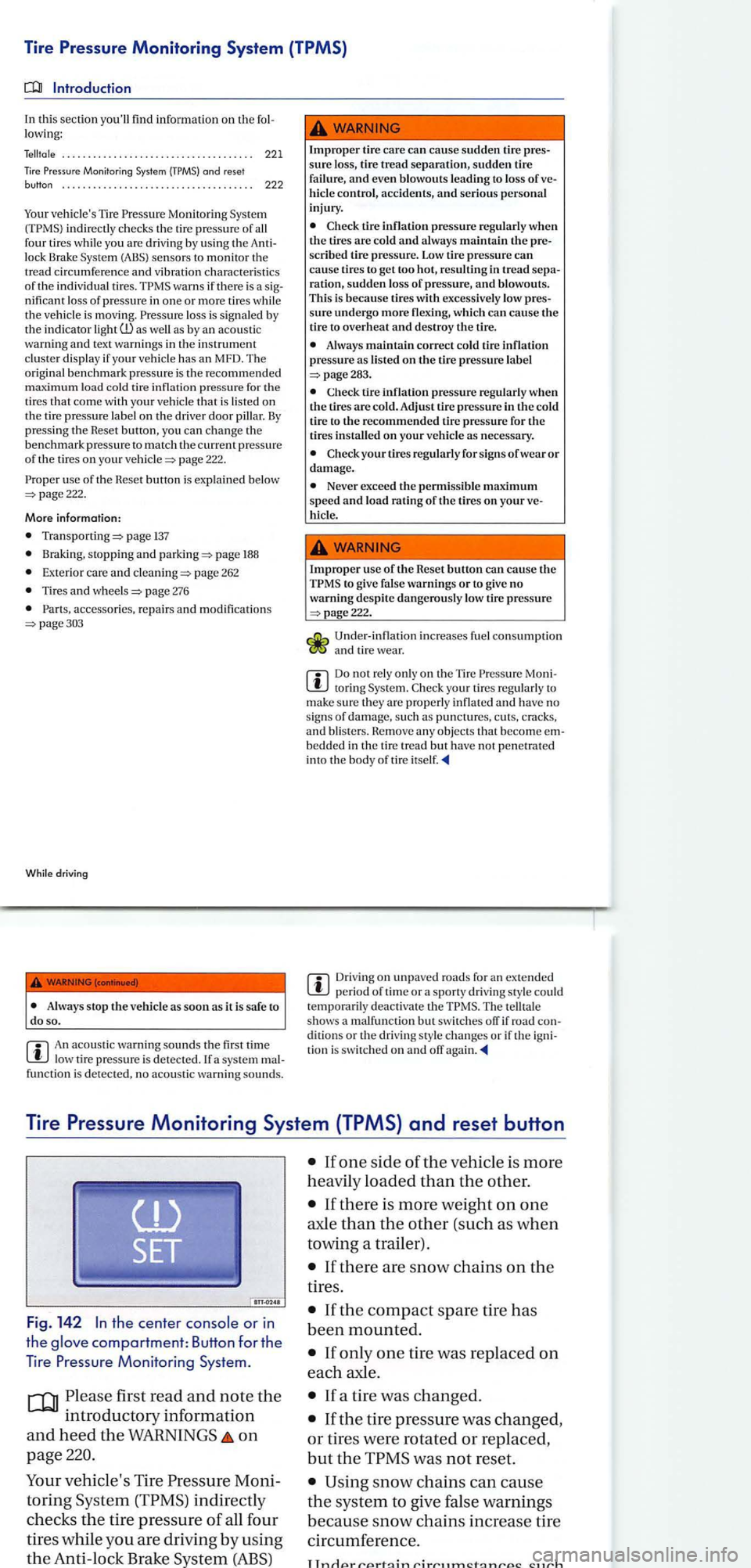
Tire Pressure Monitoring System (TPMS)
this section you'll find informati on on th e lowing:
. . . . . . . . . . . . . . . . . . . . . . . . . . . . . . . . . . . . . 221
Monitor ing System
Monito ring Sys te m indirectly c hecks the tire pressure of all
f our tires while you are driving by us ing the lock Brake Syste m (ABS) sensor s to monitor the
tr ea d circumf erenc e and vibration ch arac te ris tics of the indi vidua l tir es. warns if there is a nifi cant loss of pres sure in one or more tires while
the vehicl e is mo vin g. loss is s ig nale d b y
the ind icato r light as by an aco usti c
wa rni ng and text warnin gs in the in strument clu ster di spla y if your ve hicle has an MFD. The
origina l b en chmark pre ssure is th e recommended
m axi mum load cold tire inflati on pressure for the tire s that come with your vehicle that is lis te d on
th e tire pressure lab el on the dri ver door pill ar. By press ing the Reset button , yo u can ch ange the
b enchmark pressure to match th e c urr ent pressure of the tir es on you r page 222.
use of the Heset butto n i s explained below 222.
More informa tion:
page 137
Bra king, stopping and page 188
Ext e rior care an d page 262
page 276
pa ge303
Whil e driving
An acoustic warni ng sounds th e first time low tire pressure is detec ted. a system
Improp er tire care can cause sudden tire sure loss,
hicle control, accidents, and serious personal
injury .
tire inflation pressure regularl y when the tires are cold and alway s maintain the scribed tire pressure . Low tire pressure can cause tires to get too hot, res ultin g in tread ration, sudden lo ss of pres sure, and blowout s.
Thi s is because tires with excessively low
sure undergo more flexi ng, which can cau se the tir e to overheat and destroy the tire.
Always maintain correct cold tire inflation pressure as listed on the tire pressure label
Check tire inflation pressure regularl y when the tires are cold. Adjust tir e press ure in the cold
tir e to the recommended tire pressure for t11e tires installed on your vehicl e as necessary.
Neve r exceed the permissi ble maximum speed and load rating of the tires on your hicl e.
Imprope r us e of the Reset button can cause the to give false warnings or to give no
warning des pite dangerou sly lo w tire pressure
page222.
Und er- inflat ion increases fue l con sumptio n and tire wear.
to ring Syste m.
bedde d in the tir e tre ad but have n o t penetrated
int o the body of tire
Driving on u npaved roads for an extended
The te lltal e
s h ows a malfunc tion but switch es orr if road dit io ns or th e drivin g sty le c han ges or if th e tio n is switch ed on and orr
Tire Pressure Monitoring System (TPMS) and reset button
the center or in
the compartment: Button for th e
T
ire Pressure Monitoring System.
first r ead and note the
introductory informatio n
and heed the WARNINGS on
page
ve hicle's Tir e Moni
torin g
indirectly
c h ec ks
the ti re pressure of al l four
tire s while yo u are drivin g by us
ing
the Anti -loc k
If there is more weight on one
axle than the other (such as when
towin g a trailer) .